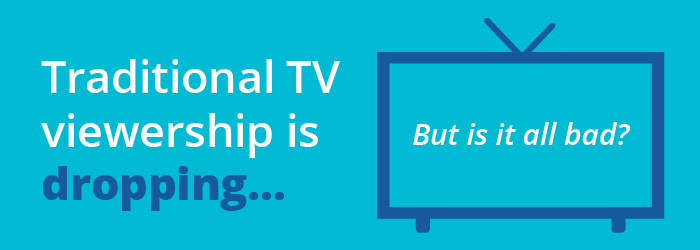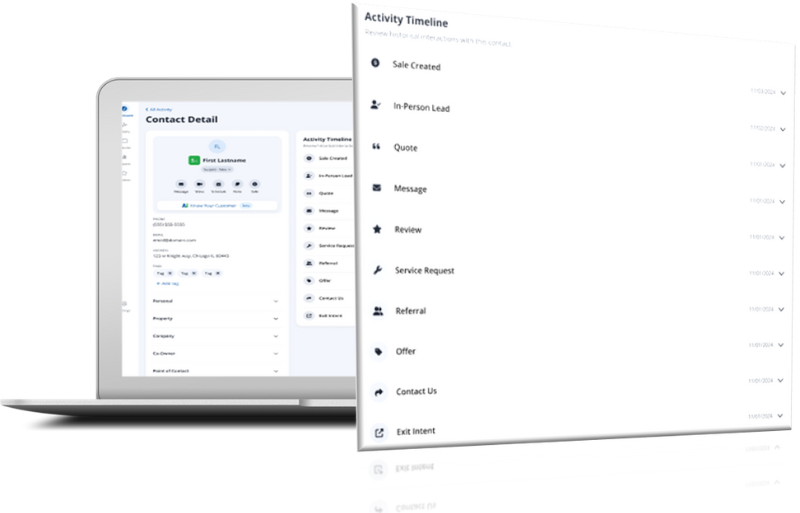Traditional TV Viewership is Dropping, But is It All Bad?

Game of Thrones, Billions, The Office— you’ve seen them all before and more and more similar binge-worthy programs seem to be airing online these days. Even shows like The Office that originally aired on traditional TV platforms, are being consumed mainly online. In fact, since 2012 TV viewership on traditional cable platforms has seen a consistent drop of 11% year-over-year (source). And of that TV audience, 79% of those consumers are using DVRs to watch their TV programs (source). So now, on top of your target demographics’ consistent size decrease, you also have to worry about target audience members fast forwarding through your scheduled commercial slots!
What’s even more alarming than these numbers, though, is that there aren’t any truly concrete metrics beyond timeslot and channel demographics that commercial marketing agencies can or even will provide you. So, what do these industry changes mean for you and how do you make sure you’re not wasting your marketing dollars on the existing TV advertisement efforts you have in place?
First and foremost, you need to redefine what “TV” is. We have to stop letting TV giants like Nielsen define what TV and its audience is and start seeing what it can be. Simply put, television is the consumption of entertaining media in video format, and today that video consumption doesn’t have to be restricted by timeslot or even channel for that matter.
We live in an era where only a third of our “TV” is on a traditional television set, and with this evolution comes two main advantages.
The first, is the fact that multiple different streaming services with several forms of content created by professionals and users alike has ultimately created a saturated marketplace. This saturated marketplace then generates multiple different opportunities for you and your marketing dollars:
1) With more content, from professionally created to user-generated, you have a greater opportunity to advertise to your target demographics on a granular level. This means that instead of blindly trusting a media buyer, you can confidently target a client demographic or even a preferred household-type based on hard numbers that digital shows and media sources provide.
2) As competition rises, streaming service prices drop, offering not only cheaper options for consumers but for advertisers as well!
3) With more variety of media consumption, you have more opportunity to touch your target audience at new activity points. For instance, if your target audience is searching on YouTube or Pinterest for plumbing topics, i.e. “how to see what’s wrong with my toilet,” you can be quite certain they are actively looking for services similar to your own organizations as opposed to passively sitting on the couch and hoping that brand awareness will strike them at a later time.
The second advantage, and arguably the most valuable advantage, to this TV evolution is the ability to track every consumer in the marketplace. Tracking fills the gaps that traditional TV advertisement has created and provides numerous marketing benefits:
1) Truly understand your target demographic instead of guessing based on a media buyer’s assumption of who watches each particular network
2) Gather concrete insight into your Cost Per Lead and Cost Per Sale for each media channel/platform
3) Track where your target demographic consumes media online and ultimately touch them with a variety of push and pull advertising methods
Overall, this digital TV and media world that we live in gives you a new opportunity to track your dollar amounts and even improve your marketing ROI. By simply shifting your focus away from strictly brand advertising via TV, you’ll see a drastic drop in CPL and a rise in overall sales as well. In fact, by utilizing both online video and traditional TV campaigns, marketers can increase their ad effectiveness by 54% (source).To prove it, here are just a few different instances where we’ve seen our home remodeling companies take advantage of this digital evolution and increase their sales today:
Customer 1: Looked to the Future
One of our home remodeling companies took the wise and bold leap to turn off TV advertising and focus their marketing dollars on branded Facebook advertising and general digital strategies. This original marketing mix of 65% digital and 35% traditional cable advertising was shifted to 100% digital marketing strategy, resulted in an 14% increase in site traffic and a 25% increase in overall leads.
Customer 2: Was Stuck in the Past
One of our many home remodeling companies who focuses their marketing dollars on TV advertising, wanted to see what would happen if they just focused on TV ads, and nothing else. So, for two weeks (two week increments within similar months were used to avoid any possible effects from seasonality) we turned off their paid search advertising and the results were striking.
Between Period 1 (a two-week period with paid search on) and Period 2 (a two-week period with paid search off), revenue dropped by 63%.
But what’s more is that the following weeks revenue was 169% higher when paid search was turned on and combined with TV ads.
The same could happen for you if you shift your marketing dollars or even repurpose your video ads to YouTube and other display network opportunities via paid search!










